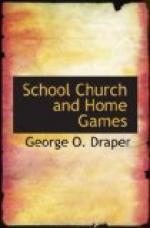The group form a circle and are counted off in 2’s. The Number 1’s are given a ball or some other object easily tossed, at one side of the circle and the Number 2’s a like object on the other side of the circle. Then 1 competes against 2 in an endeavor, by passing the object around the circle, to have it overtake that passed by the other team. When the object passed by one team has overtaken and passed that of the other, it counts one point and the game starts over, with the objects on opposite sides of the circle.
Poison
The group forms a circle, linking hands. In the center of the circle is placed on end a short log about a foot long. (A tall bottle may be used in place of the log). By it is lying a soft playground baseball or a yarn ball. The circle begins to rotate around the log, the object being to keep from knocking the club over, on the one hand, but to force some one else in the circle to knock it over. The instant it falls, the circle dissolves and all the players except the one who knocks over the club run, while he picks up the ball and throws it at the running players. If he succeeds in hitting some one, the one hit is out of the game. If he fails, he is out. So the game continues until but two players are left.
Fox Trail
[Illustration]
A large circle is drawn upon the ground. This should measure from 30 to 40 feet in radius. Another circle is drawn within this first circle and should have a radius 10 feet less than the first. Eight or 10 spokes are drawn from the center to the circumference. Where these spokes intercept the outer circle a small circle is drawn. These small circles are known as “dens”. A player is placed in each one of these dens. Another player is known as the hunter and stands at the hub of the wheel. The players in the dens are known as foxes. There is to be one more fox than den. This odd fox can stand anywhere else on the rim, where he tries to get a den whenever he can. The object of the game is that the foxes run from den to den without being caught by the hunter. The method of running, however, is restricted. Both foxes and hunter are obliged to keep to the trails running only on the lines of the diagram. It is considered poor play to run from den to den on the outer rim, as there is practically no risk in this. Foxes may run in any direction on the trail, on the spokes or on either of the rims. They may not turn back, however, when they have started on a given trail, until they have run across to the intersection of another line. If the hunter succeeds in tagging a fox, the two exchange places, the fox becoming the hunter. This is a good game to play in the snow marking the trails in the snow.




